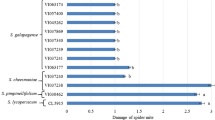Summary
The green peach aphid (Myzus persicae) is a serious pest of the tomato (Lycopersicon esculentum). Trichome-based host plant resistance of wild Lycopersicon species may offer an alternative to pesticides for management of this pest. Two wild species, Lycopersicon cheesmanii f. minor and L. pennellii, were crossed with L. esculentum and the types and densities of trichomes possessed by the F1 hybrids measured. The effects of these trichomes on M. persicae were assessed by placing nymphs on leaves and, 96 hr later, designating each nymph as either dead, alive, emigrating off the leaf or unaccounted for. A generalised linear model was used to detect relationships between the numbers of nymphs in each designation and the densities of trichomes and leaf area. Mortality of nymphs on L. pennellii hybrids was associated with high densities of type IV and low densities of type I trichomes. Mortality of nymphs on L. cheesmanii f. minor hybrids was associated with high densities of type III trichomes. An increase in the densities of type III trichomes on L. pennellii hybrids was associated with greater numbers of nymphs emigrating off the leaf whilst unaccounted nymphs on L. pennellii hybrids were associated with increased densities of type VII and type I trichomes. Further experimentation using excised leaflets found mortality on L. pennellii hybrids may be due to nymphs being hindered by type I trichomes and increased densities of type V trichomes were associated with greater numbers of unhindered nymphs. Implications of results are discussed in the context of introducing trichome-based host plant resistance into L. esculentum.
Similar content being viewed by others
References
Carter, C.D. & J.C. Snyder, 1985. Mite responses in relation to trichomes of Lycopersicon esculentum × L. hirsutum F2 hybrids. Euphytica 34: 177–185.
Erb, W.A., R.K. Lindquist, N.J. Flickinger & M.L. Casey, 1993. Resistance of selected interspecific Lycopersicon hybrids to Liriomyza trifolii (Diptera. Agromyzidae). J Econ Entomol 86: 100–109.
Erb, W.A., R.K. Lindquist, N.J. Flickinger & M.L. Casey, 1994. Resistance of selected interspecific Lycopersicon hybrids to greenhouse whitefly (Homoptera: Aleurodidae). Fla Entomol 77: 104–116.
Genstat Committee, 2002. Reference Manual. Clarendon Press, Oxford.
Goffreda, J.C., M.A. Mutschler, D.A. Ave, W.M. Tingey & J.C. Steffens, 1989. Aphid deterrence by glucose esters in glandular trichome exudate of the wild tomato, Lycopersicon pennellii. J Chem Ecol 15: 2135–2147.
Goffreda, J.C., M.A. Mutschler & W.M. Tingey, 1988. Feeding behavior of potato aphid affected by glandular trichomes of wild tomato. Entomol Exp Appl 48: 101–107.
Goffreda, J.C., J.C. Steffens & M.A. Mutschler, 1990. Association of epicuticular sugars with aphid resistance in hybrids with wild tomato. J Am Soc Hortic Sci 115: 161–165.
Gurr, G.M. & D. McGrath, 2001. Effect of plant variety, plant age and photoperiod on glandular pubescence and host-plant resistance to potato moth (Phthorimaea operculella) in Lycopersicon spp. Ann Appl Biol 138: 221–230.
Hartman, J.B. & D.A. St Clair, 1999. Combining ability for beet armyworm, Spodoptera exigua, resistance and horticultural traits of selected Lycopersicon pennellii-derived inbred backcross lines of tomato. Plant Breed 118: 523–530.
Heinz, K.M. & F.G. Zalom, 1995. Variation in trichome-based resistance to Bemisia argentifolii (Homoptera: Aleyrodidae) oviposition on tomato. J Econ Entomol 88: 1494–1502.
Juvik, J.A., M.J. Berlinger, T. Ben-David & J. Rudich, 1982. Resistance among accessions of the genera Lycopersicon and Solanum to four of the main insect pests of tomato in Israel. Phytoparasitica 10: 145–156.
Juvik, J.A., J.A. Shapiro, T.E. Young & M.A. Mutschler, 1994. Acylglucoses from wild tomatoes alter behavior and reduce growth and survival of Helicoverpa zea and Spodoptera exigua (Lepidoptera: Noctuidae). J Econ Entomol 87: 482–492.
Lange, W.H. & L. Bronson, 1981. Insect pests of tomatoes. Annu Rev Entomol 26: 345–371.
Lemke, C.A. & M.A. Mutschler, 1984. Inheritance of glandular trichomes in crosses between Lycopersicon esculentum and Lycopersicon pennellii. J Am Soc Hortic Sci 109: 592–596.
Liedi, E., D.M. Lawson, K.K. White, J.A. Shapiro, D.E. Cohen, W.G. Carson, J.T. Trumble & M.A. Mutschler, 1995. Acylsugars of wild tomato Lycopersicon pennellii alters settling and reduces oviposition of Bemisia argentifolii (Homoptera: Aleyrodidae). J Econ Entomol 88: 742–748.
Luckwill, L.C., 1943. The Genus Lycopersicon: An Historical, Biological and Taxanomic Survey of the Wild and Cultivated Tomatoes. Aberdeen University Press, Aberdeen.
Muigai, S.G., D.J. Schuster, J.C. Snyder, J.W. Scott, M.J. Bassett & H.J. McAuslane, 2002. Mechanisms of resistance in Lycopersicon germplasm to the whitefly Bemisia argentifolii. Phytoparasitica 30: 347–360.
Nihoul, P., 1993. Do light intensity, temperature and photoperiod affect the entrapment of mites on glandular hairs of cultivated tomatoes. Exp Appl Acarol 17: 709–718.
Schuster, D.J., 1977. Resistance in tomato accessions to the tomato pinworm. J Econ Entomol 70: 434–436.
Simmons, A.T., 2005. Trichome-Based Pest Management in the Tomato Crop: One Step Closer to a Reality? Ph.D. Thesis, The University of Sydney, Orange.
Simmons, A.T. & G.M. Gurr, 2004. Trichome-based host plant resistance of Lycopersicon species and the biocontrol agent Mallada signata: Are they compatible? Entomol Exp Appl 113: 95–101.
Simmons, A.T., G.M. Gurr, D. McGrath, H.I. Nicol & P.M. Martin, 2003. Trichomes of Lycopersicon spp. and their effect on Myzus persicae (Sulzer) (Hemiptera: Aphididae). Aust J Entomol 42: 373–378.
Simmons, A.T., G.M. Gurr, D. McGrath, H.I. Nicol & P.M. Martin, 2004. Entrapment of Helicoverpa armigera (Hübner) (Lepidoptera: Noctuidae) on glandular trichomes of Lycopersicon species. Aust J Entomol 43: 196–200.
Snyder, J.C. & J.P. Hyatt, 1984. Influence of daylength on trichome densities and leaf volatiles of Lycopersicon species. Plant Sci Lett 37: 177–181.
Author information
Authors and Affiliations
Corresponding author
Rights and permissions
About this article
Cite this article
Simmons, A.T., McGrath, D. & Gurr, G.M. Trichome characteristics of F1 Lycopersicon esculentum × L. cheesmanii f. minor and L. esculentum × L. pennellii hybrids and effects on Myzus persicae. Euphytica 144, 313–320 (2005). https://doi.org/10.1007/s10681-005-8002-x
Received:
Accepted:
Issue Date:
DOI: https://doi.org/10.1007/s10681-005-8002-x




